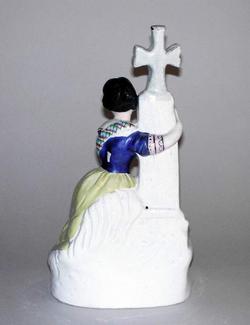Current Location: Gallery 27 (Glaisher)
Titles
Jenny Lind (as 'Alice')
Maker(s)
Production:
Unidentified factory
Entities
Categories
Description
White earthenware figure moulded in three parts and pearlware glazed. Painted with black, grey, blue, red, pink, green yellow and flesh-pink enamels, and gilt.
Jenny Lind sits with her hands clasped around a pillar which supports a stone cross; she looks away from the cross, over her left shoulder. The rectangular base is rounded to the back and one side and decorated with an impressed pattern and gilt touches; the front is moulded in rococo style and bears the title ‘Jenny Lind as Alice in Meyerbeer’s Opera’ in gilt script, on a ribbon. The figure is well coloured. The cross is grey, outlined in black, and a pink and green vine winds up the pillar. Jenny Lind wears a low blue bodice with pink cuffs, a tartan sash with red tasselled edge, and a flowered yellow skirt. Her black hair is tied back in a bun. The underside is concave and glazed. The back is moulded and decorated for the upper body only, and has a vent hole 12.5cm from the bottom.
Notes
History note: Wm Brough and Sons, 312 and 313 Broad Street, Birmingham, bought on 29 May, 1913 for £2 and five shillings, by Dr Glaisher, Trinity College, Cambridge.
Legal notes
Dr J.W.L. Glaisher Bequest
Measurements and weight
Depth: 12.5 cm
Depth: 5 in
Height: 34.5 cm
Height: 13.5 in
Width: 18.5 cm
Width: 7.25 in
Acquisition and important dates
Method of acquisition: Bequeathed
(1928)
by
Glaisher, J. W. L., Dr
Dating
19th Century, Mid
Victoria I
Production date:
circa
AD 1847
Note
Jenny Lind (1820-1887) was a Swedish opera soprano. She sang with Verdi, and Mendelssohn wrote the soprano part in Elijah for her. She is believed to have inspired several Hans Christian Andersen stories, including The Ugly Duckling and The Emperor’s Nightingale. In May 1847, she made her London debut in the role of Alice in Meyerbeer’s opera, Roberto il diavolo (Robert the Devil) at the Theatre Royal, Haymarket, to immense popular acclaim – it is said that Queen Victoria threw her a bouquet rom the Royal Box. In later life she raised substantial funds for good causes, such as Florence Nightingale’s Nursing Fund and The Railway Servants’ Benevolent Fund.
Rackham (1935) lists this figure as of a type made chiefly by Sampson Smith at Longton, a factory listed in contemporary directories as a ‘manufacturer of figures in great variety’, which began around 1851 and continued to make figures in quantity into the early part of the twentieth century. But Sampson Smith figures were rarely marked, and typically have a flat, undecorated back and plain oval base, and are made without subsidiary mouldings. Meanwhile there were many other, sometimes smaller, manufacturers of figures working in Staffordshire at this time.
The source for this figure is a coloured lithograph of Jenny Lind as Alice in Meyerbeer’s Opera, Roberto il Diavolo, by T. Packer, which shows Lind in the same pose and dress. An engraving in The London Illustrated News of 8th May 1847 also shows her in a similar pose, but recoiling in fear from a male character who points aggressively at her (see Pugh (1970), pp.74 and 455). The existence of several differently moulded Jenny Lind figures based on these illustrations indicates their popularity, and that they were made by a number of different manufacturers. Pugh (1970) estimates that, in all, some 18 different Jenny Lind figures were made.
School or Style
Victorian
People, subjects and objects depicted
Components of the work
Decoration
composed of
enamels
( black, grey, blue, red, pink, green yellow and flesh-pink)
gold
Materials used in production
White earthenware
Lead-glaze
Techniques used in production
Press moulding
: White earthenware moulded in three parts and pearlware glazed. Painted with black, grey, blue, red, pink, green yellow and flesh-pink enamels, and gilt. The underside is concave and glazed. The back is moulded and decorated for the upper body only, and has a vent hole 12.5cm from the bottom.
Painting
Lead-glazing
Gilding
Inscription or legends present
Inscription present: in gilt script, on a ribbon
- Text: Jenny Lind as Alice in Meyerbeer’s Opera
- Location: Front of base
- Method of creation: Painted in gold
- Type: Name
Inscription present: rectangular paper label
- Text: No. 3622 Large Staffs statuette of Jenny Lind kneeling and clasping a cross. b. May 29, 1913. Came from Birmingham
- Location: Underside of base
- Method of creation: Handwritten in black ink
- Type: Label
References and bibliographic entries
Identification numbers
Accession number: C.1014-1928
Primary reference Number: 71141
Old object number: 3622
Stable URI
Audit data
Created: Saturday 6 August 2011
Updated: Tuesday 30 April 2024
Last processed: Thursday 14 August 2025
Associated departments & institutions
Owner or interested party:
The Fitzwilliam Museum
Associated department:
Applied Arts





